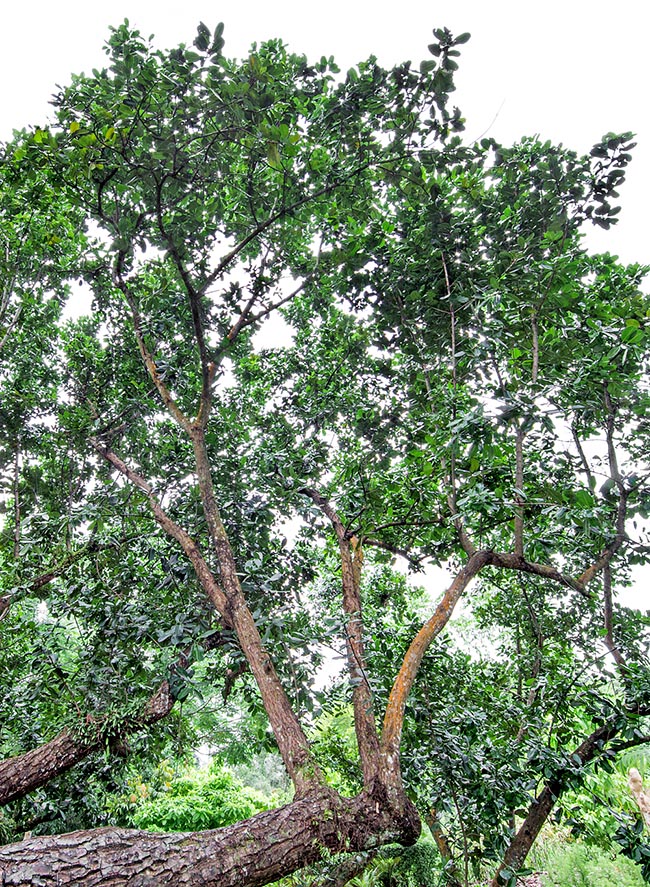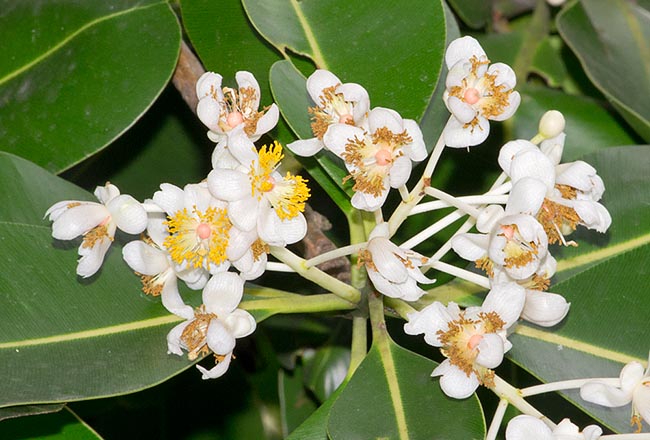Family : Clusiaceae

Text © Pietro Puccio

English translation by Mario Beltramini

At home along the Indian and Western Pacific Oceans coasts, Calophyllum inophyllum is a 5-20 m tree often considered sacred by natives. All parts of the plant contain toxic substances, the sap is irritant for skin and eyes and can cause allergic reactions. From seeds they get an oil with medicinal virtues © Giuseppe Mazza
The species is native to Australia (Northern Territory and Queen- sland), Cambodia, China (Hainan), Comoro Islands, Cook Islands, Fiji, French Polynesia (Marquesas Islands, Society Islands), Guam, India, Indonesia, Japan, Kenya, Madagascar, Malaysia, Marshall Islands, Mauritius, Micronesia, Mozambique, Northern Mariana Islands, Palau, Papua New Guinea, Philippines, Samoa, Seychelles, Sri Lanka, Taiwan, Tanzania, Thailand and Vietnam, where it grows in open areas along the rocky and sandy coasts, often being the dominant species, up to about 100 m of altitude; the fruits float and are dispersed by the sea currents.
The name of the genus is the combination of the Greek adjective “καλός” (kalos) = beautiful and of the substantive “φύλλον” (phyllon) = leaf, with obvious reference; the specific name is the combination of the Greek substantives “ις, ινος” (is, inos) = fibre and “φύλλον” (phyllon) = leaf, with reference to the nervations of the leaves.
Common names: alexandrian-laurel, Bali nut tree, balltree, beach calophyllum, beach touriga, beauty leaf, Borneo-mahogany, Indian doomba oiltree, Indian-laurel, laurelwood, mastwood, portia tree, poon, satin touriga, tacamahac-tree, tamanu (Eglish); hai-tang-guo, hong hou ke, hu tong (Chinese); bitaog, bitong, butulau, dangkalan (Tagalog); kamani (Hawaiian); sultana-champa, sultan champa, surpan, surpunka (Hindi); nyamplung (Javanese); abricò (Portuguese-Brazil); nag champa (Sanskrit); palo de Santa María, palo María, undi (Spanish); motondoo, mtondoo, mkanja (Swahili); kating, kra thing (Thai); cong, mù u (Vietnamese).
The Calophyllum inophyllum L. (1753) is an evergreen tree, 5-20 m tall, with thick foliage and brownish bark, vertically fissured, with whitish, yellowish or transparent sap getting out from the wounds. The leaves, on a 1-2,5 cm long petiole, are opposite, simple, elliptic to obovate-elliptic with obtuse to retuse apex and entire margin, 8-20 cm long and 4-9 cm broad, coriaceous and glossy above and below, with prominent central nervation, of intense green colour. The inflorescences at the upper axils, are 8-15 cm long panicles, carrying 5-15 flowers, on a 2-4 cm long pedicel, bisexual, white, of 2-2,5 cm of diameter, with 4 petaloid sepals of which two external roundish and two internal obovate, 4 obovate petals, 1-1,2 cm long, concave, and a crowd (200-350) of free yellow stamina; the flowers emit a pleasant intense scent.
The fruits are globose drupes, initially green, brownish yellow when ripe, of 2,5-5 cm of diameter, containing only one globose brown seed, 1,5-4 cm long. The fruits are not edible due to the presence of toxic substances.

The inflorescences emit a pleasant intense scent © Giuseppe Mazza
It reproduces by seed, in sandy loam maintained at the temperature of 24-26 °C, with germination times, if without endocarp, of about one month; the initial growth is slow and the first blooming occurs after 7-8 years. Tree amply diffused in nature that has had an important role in the life of many populations, in particular those of the Pacific, so much to be considered sacred by some of them, is frequently utilized due to its remarkable ornamental characteristics in the parks and gardens of the tropical and subtropical countries, isolated or in group, as shade tree and as street tree, is also employed as windbreak and for stabilizing the soils. Requires full sun or, at most, a slight shade and can grow in an ample variety of soils, even rocky, calcareous and saline, but prefers those well drained, sandy, acidic to slightly alkaline, furthermore resists to the strong winds, the marine aerosols and to periods of drought as well as to the floodings, provided of short duration, does not bear temperatures of less than 8 °C.
All parts of the plant contain toxic substances, the sap is irritant for the skin and the eyes and may cause allergic reactions. The dried seeds contain up to about the 70% of a viscous oil, toxic if not refined, formed by palmitic acid (15%), stearic (13%), oleic (49%), linoleic (21%), linolenic (0,3%), arachidic (0,9%) and eicosenoic (0,7%). The refined oil is utilized in the soaps, cosmetic and pharmaceutical industries and since remote times in the traditional medicine for the treatment of the skin diseases, arthritis and sciatica and disinfection and wound healing, and is object of pharmacological researches, along with the other parts of the plant, for the promising antinflammatory, anti-bacterial, antifungal, insecticide and cicatrizant. The wood, hard and heavy (560-800 kg/m3), resistant to the termites, is used for boats, in the constructions of dwellings, for furniture, common use objects and musical instruments. The flowers in Polynesia are utilized for the characteristic garlands and as ornament for hairs.
Synonyms: Balsamaria inophyllum Lour. (1790); Calophyllum ovatifolium Noronha (1790); Calophyllum spurium Choisy (1823); Calophyllum bingator Roxb. (1824); Calophyllum blumei Wight (1840); Calophyllum apetalum Blanco (1845); Calophyllum inophyllum f. oblongata Miq. (1854); Calophyllum inophyllum f. obovata Miq. (1854); Calophyllum wakamatsui Kaneh. (1934); Calophyllum inophyllum var. takamaka Fosberg (1974); Calophyllum inophyllum var. wakamatsui (Kaneh.) Fosberg & Sachet (1980).
→ To appreciate the biodiversity within the CLUSIACEAE family please click here.
